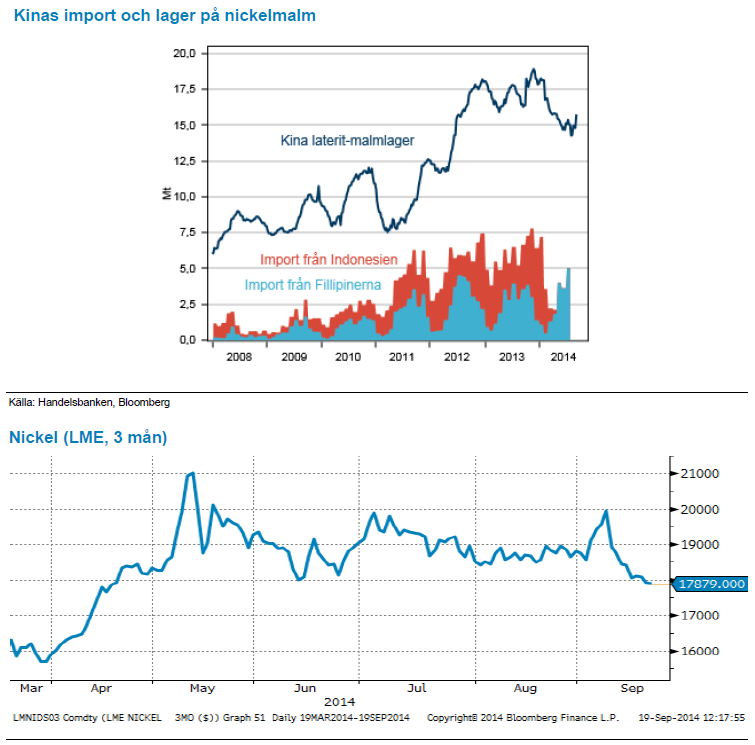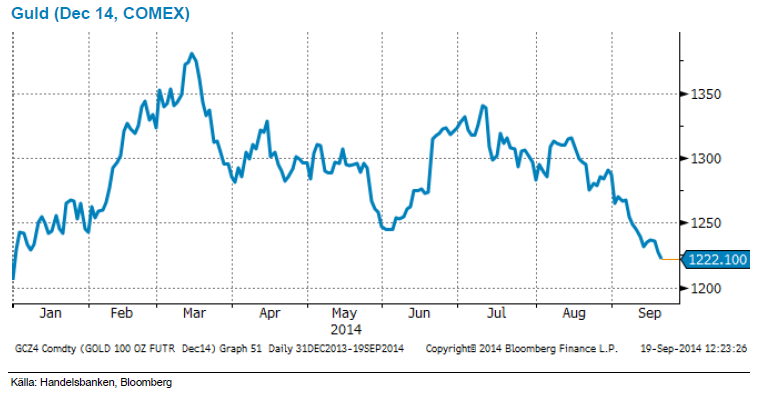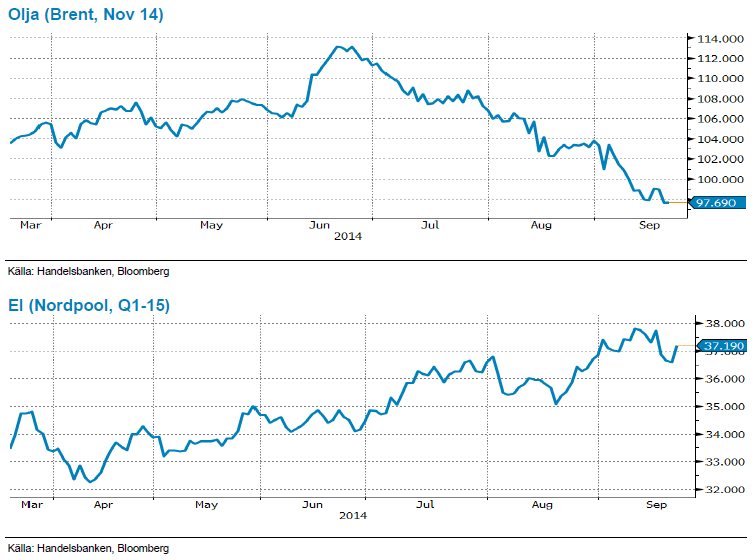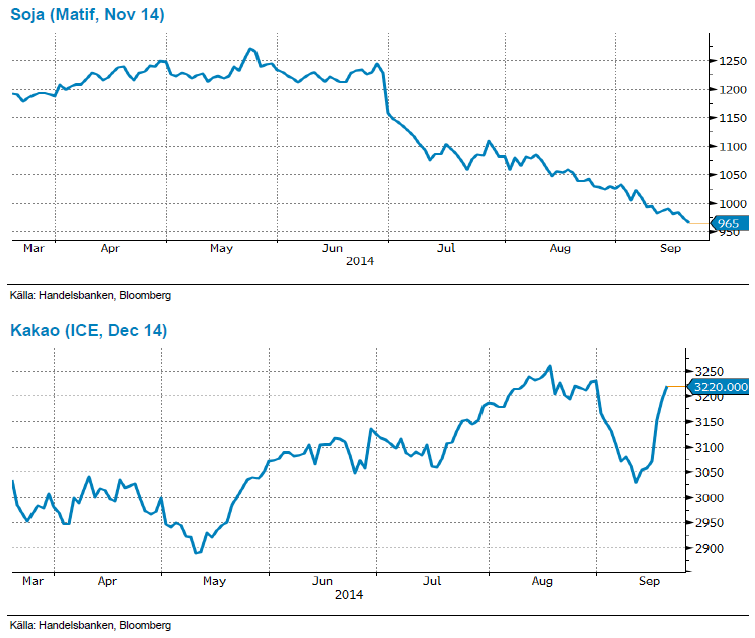Analys
SHB Råvarubrevet 19 september 2014

 Råvaror allmänt: Hektisk vecka
Råvaror allmänt: Hektisk vecka
Veckan inleddes med att marknaden absorberade helgens usla makrodata från Kina. Industriproduktionen och investeringar föll båda handlöst likt i våras efter att ha stabiliserat sig under sommaren. Vårens ministimulanser är uppenbarligen slut och utan dem så svajar kinas ekonomi.
 Redan på måndagskvällen stöttade dock kinesiska ledare upp med en rejäl likviditetsboost till de fem stora bankerna. På detta besked steg sedan råvaror och främst basmetaller ordentligt. Händelsen ska tolkas som att Kina är på väg att missa sitt helårsmål på 7,5 % tillväxt och framöver kan man ana att man ska tolka svag data från Kina som goda nyheter då det ökar sannolikheten för mer stimulanser som främst driver basmetaller uppåt.
Redan på måndagskvällen stöttade dock kinesiska ledare upp med en rejäl likviditetsboost till de fem stora bankerna. På detta besked steg sedan råvaror och främst basmetaller ordentligt. Händelsen ska tolkas som att Kina är på väg att missa sitt helårsmål på 7,5 % tillväxt och framöver kan man ana att man ska tolka svag data från Kina som goda nyheter då det ökar sannolikheten för mer stimulanser som främst driver basmetaller uppåt.
På onsdagen kom sedan Feds efterlängtade besked kring penningpolitiken. Inga stora överraskningar, Fed-chef Yellen fortsatt mjuk i tonen men det faktum att räntebanan skruvats upp och att 2 istället för 1 ledamot reserverade sina röster tolkades som ”hökigt” (det vill säga ökad risk för stigande ränta). Guld handlades ner på beskedet men stabiliserades dagen efter. Övriga råvaror hade det dock tungt i bakvattnet av Fed, främst på grund av att dollarn stärktes.
USA fortsätter leverera bra makrodata, i veckan som husbyggnation. I Kina föll däremot fastighetspriserna i 68 av de uppmätta 70 städerna. Marknaden där är i ordentlig gungning men vi tror att stimulanser kommer hjälpa basmetallerna förbi motståndet i Kina och vänta oss vidare draghjälp från USA-data.
Basmetaller: Svag kinadata kan vara positivt
Basmetallerna har haft en tuff månad där samtliga metaller pressats av ett allt svagare kina. Totalt sett har vårt basmetallindex fallit med 4 % denna månad. Värst drabbad är aluminium och nickel varit som fallit med 5-6 % under september.
Rykten kring exportförbud av oförädlad malm från Filippinerna har tystnat för stunden. Ett eventuellt förbud tar sannolikt 2-5 år att implementera om man jämför med utvecklingen i Indonesien. Kinas lager av nickelmalm tar längre tid att beta av än tidigare prognostiserats, då import har ersatts med Filippinskt, men när lagren börjar sina ser vi nytt stöd för nickelpriset – men det kan dröja några månader. Vi har varit positiva till basmetaller ett tag nu men har överraskats av den svaga utvecklingen i Kina. Nu har situationen vänt och svag kinadata kan vara positivt för metallerna då mer stimulans från ledarna väntas. Vi behåller därför kvar vid vår positiva vy.
Ädelmetaller: Neutrala till guldet
Guld och övriga ädelmetaller fortsätter att uppvisa små rörelser, ”caught between a rock and a hard place” i form av Fed:s kommunikation om framtida åtstramningar, vilken ställs emot geopolitisk oro och ”säker-hamn-köp”. Dollarns förstärkning under 2014 har gjort att svenska guldköpare har sett sina innehav stiga med nära 12 procent i år, och fallet från sommarens toppar begränsas till ca 4 procent.
Vi har neutral vy i denna situation, men fortsätter att påminna om de faktorer som man ska hålla koll på; förväntningarna på när Fed stramar åt sin ultralätta räntepolitik (ju förr dess sämre…) ska ställas mot oro över Putin, ISIS och andra mörka geopolitiska moln. Bägge dessa huvudpoler är sannolikt ömsesidigt beroende, skulle Ukraina-spänningarna – och därtill kopplade ekonomiska sanktioner – lätta så skulle sannolikt tillväxtprognoser i Europa (och globalt) justeras upp efter en tid, och därmed skulle en Fed-åtstramning krypa närmare. Och naturligtvis tvärt om.
Ur ett portföljperspektiv ser vi – baserat på ovanstående resonemang – fortfarande bra skäl till att ha en andel guld i portföljen. Skulle spänningarna tillta så är det inte osannolikt att övriga tillgångar tappar i värde. Guldets roll som en geopolitisk ”försäkring” är intakt, och nuvarande nivåer att gå in skrämmer inte värderingsmässigt.
Energi: Oljan fortsatt under 100 USD/fat
Oljepriset håller sig under 100 USD strecket denna vecka och handlas nu strax under 98 USD/fat. Oljan är svag då produktionstillväxten framför allt i USA överstiger efterfrågan. Så vi har tre intressanta frågeställningar som vi ser det.
Första är om OPEC kommer besluta att sänka produktionen vid mötet i november. Saudi drog ned sin produktion redan i augusti (ned 408kbpd och största sedan 2012) men det lär dröja flera månader innan ytterligare neddragningar och ett ökat intresse från Kina får ner lagersiffrorna mot ”normala” nivåer så sannolikt att brentkurvan (spot/aug15) förblir i stark contango (stigande priser) men sedan planar ut. Den andra frågan är angående Libyens produktion. Libyen har överraskat mot slutet av sommaren men frågan är om det är det hållbart. Vi hade ett starkt rally i veckan efter att Libyen stängde Shahara fältet och alltmer tyder på att uppgången i oljeproproduktion/export är temporär och kommer få ett bakslag vilket lär kunna bli en trigger. Den sista frågeställningen är om Rysslands energiexport kommer fortsätta då Ryssland är lika beroende av Europa som Europa är av Ryssland vad gäller olja och gas. Och i så fall till vilket pris? Kan och vill USA i sin strävan att bli självförsörjande fortsatt bidra till ett pressat oljepris och sätta ytterligare press på Ryssland? Summa summarum… potentialen finns på uppsidan trots allt.
Ser vi till elmarknaden har vädret varit den prisdrivande faktorn även denna vecka. Ett kort uppställ på kalla/torra prognoser men där uppgången kom av sig på förväntad nederbörd över normalen och en viss förbättrad energibalans (ca -7 TWh om vi ser till Markedskrafts prognoser) samtidigt som spotnoteringarna kommer in överraskande lågt. Kolpriserna har backat till nya rekordlåga nivåer och ser ut att kunna backa ytterligare på det goda utbudet på exportmarknaden och eftersom även gasen ser ut att visa svaga tendenser ute på kurvan finns det egentligen inte så mycket som talar för ett stigande elpris just nu. Vi bör dock ha diskonterat vädret till viss del redan så neutral till kort position om något.
Livsmedel: Idealiskt väder har pressat sojan
Priset på soja (sojabönor) har fortsatt ned under veckan med nästan 2 %. Hela växtsäsongen har hittills präglats av nära nog idealiskt väder för den amerikanska sojan och förväntningarna på kommande skörd är fortsatt väldigt hög – hela tiden inkommer rapporter om mycket hög avkastning.
Senaste dagarna har gett varmare väder vilket minskat oro för frost och risken för väderrelaterade bakslag blir allt mindre. Tills ett eventuellt väderproblem dyker upp i Brasilien, där skörden startar efter årsskiftet, är det för tillfället svårt att se varför sojapriser ska vända uppåt. Vi tror snarare att den höga avkastningen kan pressa ned priserna ytterligare något – även om nedsidan nu känns mer begränsad efter så stora fall.
Stigande kakaokonsumtion har gett stöd åt priserna under året men senaste tidens starka dollar har fått både kakao- och kaffepriserna att backa tillbaka. Prognoserna för augusti månads kakaoproduktion justerades upp jämfört från föregående säsong och gynnsamma väderförhållanden väntas i de viktiga kakaoregionerna. Trots lovande prognoser på produktionssidan har kakaopriserna stigit drygt 4 procent under veckan, detta efter oro om Ebolaspridning i Västafrika. Sedan fallet efter starkare dollar har kaffepriserna dansat sidledes efter viss nederbörd. Situationen är långt ifrån stabil, mer regn behövs varför vi tror på svag uppgång den närmaste tiden. Och vad gäller kakao intar vi en neutral vy men följer utvecklingen av spridningen av Ebolaviruset i Afrika.
Handelsbankens råvaruindex (USD)
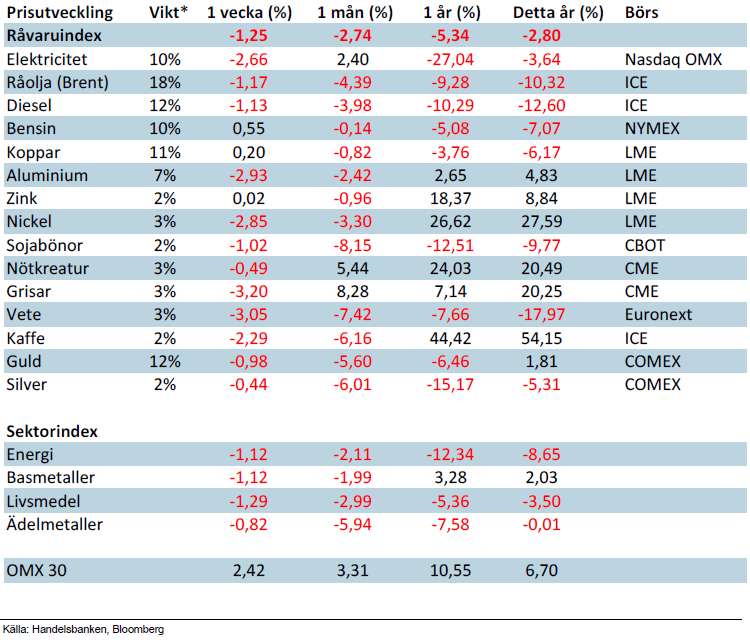
*Uppdaterade vikter från 29 november 2013
Handelsbankens råvaruindex består av de underliggande indexen för respektive råvara. Vikterna är bestämda till hälften från värdet av nordisk produktion (globala produktionen för sektorindex) och till hälften från likviditeten i terminskontrakten.
[box]SHB Råvarubrevet är producerat av Handelsbanken och publiceras i samarbete och med tillstånd på Råvarumarknaden.se[/box]
Ansvarsbegränsning
Detta material är producerat av Svenska Handelsbanken AB (publ) i fortsättningen kallad Handelsbanken. De som arbetar med innehållet är inte analytiker och materialet är inte oberoende investeringsanalys. Innehållet är uteslutande avsett för kunder i Sverige. Syftet är att ge en allmän information till Handelsbankens kunder och utgör inte ett personligt investeringsråd eller en personlig rekommendation. Informationen ska inte ensamt utgöra underlag för investeringsbeslut. Kunder bör inhämta råd från sina rådgivare och basera sina investeringsbeslut utifrån egen erfarenhet.
Informationen i materialet kan ändras och också avvika från de åsikter som uttrycks i oberoende investeringsanalyser från Handelsbanken. Informationen grundar sig på allmänt tillgänglig information och är hämtad från källor som bedöms som tillförlitliga, men riktigheten kan inte garanteras och informationen kan vara ofullständig eller nedkortad. Ingen del av förslaget får reproduceras eller distribueras till någon annan person utan att Handelsbanken dessförinnan lämnat sitt skriftliga medgivande. Handelsbanken ansvarar inte för att materialet används på ett sätt som strider mot förbudet mot vidarebefordran eller offentliggörs i strid med bankens regler.
Analys
The Mid-East anchor dragging crude oil lower

When it starts to move lower it moves rather quickly. Gaza, China, IEA. Brent crude is down 2.1% today to $62/b after having traded as high as $66.58/b last Thursday and above $70/b in late September. The sell-off follows the truce/peace in Gaze, a flareup in US-China trade and yet another bearish oil outlook from the IEA.

A lasting peace in Gaze could drive crude oil at sea to onshore stocks. A lasting peace in Gaza would probably calm down the Houthis and thus allow more normal shipments of crude oil to sail through the Suez Canal, the Red Sea and out through the Bab-el-Mandeb Strait. Crude oil at sea has risen from 48 mb in April to now 91 mb versus a pre-Covid normal of about 50-60 mb. The rise to 91 mb is probably the result of crude sailing around Africa to be shot to pieces by the Houthis. If sailings were to normalize through the Suez Canal, then it could free up some 40 mb in transit at sea moving onshore into stocks.
The US-China trade conflict is of course bearish for demand if it continues.
Bearish IEA yet again. Getting closer to 2026. Credibility rises. We expect OPEC to cut end of 2025. The bearish monthly report from the IEA is what it is, but the closer we get to 2026, the more likely the IEA is of being ball-park right in its outlook. In its monthly report today the IEA estimates that the need for crude oil from OPEC in 2026 will be 25.4 mb/d versus production by the group in September of 29.1 mb/d. The group thus needs to do some serious cutting at the end of 2025 if it wants to keep the market balanced and avoid inventories from skyrocketing. Given that IEA is correct that is. We do however expect OPEC to implement cuts to avoid a large increase in inventories in Q1-26. The group will probably revert to cuts either at its early December meeting when they discuss production for January or in early January when they discuss production for February. The oil price will likely head yet lower until the group reverts to cuts.
Dubai: The Mid-East anchor dragging crude oil lower. Surplus emerging in Mid-East pricing. Crude oil prices held surprisingly strong all through the summer. A sign and a key source of that strength came from the strength in the front-end backwardation of the Dubai crude oil curve. It held out strong from mid-June and all until late September with an average 1-3mth time-spread premium of $1.8/b from mid-June to end of September. The 1-3mth time-spreads for Brent and WTI however were in steady deterioration from late June while their flat prices probably were held up by the strength coming from the Persian Gulf. Then in late September the strength in the Dubai curve suddenly collapsed. Since the start of October it has been weaker than both the Brent and the WTI curves. The Dubai 1-3mth time-spread now only stands at $0.25/b. The Middle East is now exporting more as it is producing more and also consuming less following elevated summer crude burn for power (Aircon) etc.
The only bear-element missing is a sudden and solid rise in OECD stocks. The only thing that is missing for the bear-case everyone have been waiting for is a solid, visible rise in OECD stocks in general and US oil stocks specifically. So watch out for US API indications tomorrow and official US oil inventories on Thursday.
No sign of any kind of fire-sale of oil from Saudi Arabia yet. To what we can see, Saudi Arabia is not at all struggling to sell its oil. It only lowered its Official Selling Prices (OSPs) to Asia marginally for November. A surplus market + Saudi determination to sell its oil to the market would normally lead to a sharp lowering of Saudi OSPs to Asia. Not yet at least and not for November.
The 5yr contract close to fixed at $68/b. Of importance with respect to how far down oil can/will go. When the oil market moves into a surplus then the spot price starts to trade in a large discount to the 5yr contract. Typically $10-15/b below the 5yr contract on average in bear-years (2009, 2015, 2016, 2020). But the 5yr contract is usually pulled lower as well thus making this approach a moving target. But the 5yr contract price has now been rock solidly been pegged to $68/b since 2022. And in the 2022 bull-year (Brent spot average $99/b), the 5yr contract only went to $72/b on average. If we assume that the same goes for the downside and that 2026 is a bear-year then the 5yr goes to $64/b while the spot is trading at a $10-15/b discount to that. That would imply an average spot price next year of $49-54/b. But that is if OPEC doesn’t revert to cuts and instead keeps production flowing. We think OPEC(+) will trim/cut production as needed into 2026 to prevent a huge build-up in global oil stocks and a crash in prices. But for now we are still heading lower. Into the $50ies/b.
Analys
More weakness and lower price levels ahead, but the world won’t drown in oil in 2026

Some rebound but not much. Brent crude rebounded 1.5% yesterday to $65.47/b. This morning it is inching 0.2% up to $65.6/b. The lowest close last week was on Thursday at $64.11/b.

The curve structure is almost as week as it was before the weekend. The rebound we now have gotten post the message from OPEC+ over the weekend is to a large degree a rebound along the curve rather than much strengthening at the front-end of the curve. That part of the curve structure is almost as weak as it was last Thursday.
We are still on a weakening path. The message from OPEC+ over the weekend was we are still on a weakening path with rising supply from the group. It is just not as rapidly weakening as was feared ahead of the weekend when a quota hike of 500 kb/d/mth for November was discussed.
The Brent curve is on its way to full contango with Brent dipping into the $50ies/b. Thus the ongoing weakening we have had in the crude curve since the start of the year, and especially since early June, will continue until the Brent crude oil forward curve is in full contango along with visibly rising US and OECD oil inventories. The front-month Brent contract will then flip down towards the $60/b-line and below into the $50ies/b.
At what point will OPEC+ turn to cuts? The big question then becomes: When will OPEC+ turn around to make some cuts? At what (price) point will they choose to stabilize the market? Because for sure they will. Higher oil inventories, some more shedding of drilling rigs in US shale and Brent into the 50ies somewhere is probably where the group will step in.
There is nothing we have seen from the group so far which indicates that they will close their eyes, let the world drown in oil and the oil price crash to $40/b or below.
The message from OPEC+ is also about balance and stability. The world won’t drown in oil in 2026. The message from the group as far as we manage to interpret it is twofold: 1) Taking back market share which requires a lower price for non-OPEC+ to back off a bit, and 2) Oil market stability and balance. It is not just about 1. Thus fretting about how we are all going to drown in oil in 2026 is totally off the mark by just focusing on point 1.
When to buy cal 2026? Before Christmas when Brent hits $55/b and before OPEC+ holds its last meeting of the year which is likely to be in early December.
Brent crude oil prices have rebounded a bit along the forward curve. Not much strengthening in the structure of the curve. The front-end backwardation is not much stronger today than on its weakest level so far this year which was on Thursday last week.

The front-end backwardation fell to its weakest level so far this year on Thursday last week. A slight pickup yesterday and today, but still very close to the weakest year to date. More oil from OPEC+ in the coming months and softer demand and rising inventories. We are heading for yet softer levels.

Analys
A sharp weakening at the core of the oil market: The Dubai curve

Down to the lowest since early May. Brent crude has fallen sharply the latest four days. It closed at USD 64.11/b yesterday which is the lowest since early May. It is staging a 1.3% rebound this morning along with gains in both equities and industrial metals with an added touch of support from a softer USD on top.

What stands out the most to us this week is the collapse in the Dubai one to three months time-spread.
Dubai is medium sour crude. OPEC+ is in general medium sour crude production. Asian refineries are predominantly designed to process medium sour crude. So Dubai is the real measure of the balance between OPEC+ holding back or not versus Asian oil demand for consumption and stock building.
A sharp weakening of the front-end of the Dubai curve. The front-end of the Dubai crude curve has been holding out very solidly throughout this summer while the front-end of the Brent and WTI curves have been steadily softening. But the strength in the Dubai curve in our view was carrying the crude oil market in general. A source of strength in the crude oil market. The core of the strength.
The now finally sharp decline of the front-end of the Dubai crude curve is thus a strong shift. Weakness in the Dubai crude marker is weakness in the core of the oil market. The core which has helped to hold the oil market elevated.
Facts supports the weakening. Add in facts of Iraq lifting production from Kurdistan through Turkey. Saudi Arabia lifting production to 10 mb/d in September (normal production level) and lifting exports as well as domestic demand for oil for power for air con is fading along with summer heat. Add also in counter seasonal rise in US crude and product stocks last week. US oil stocks usually decline by 1.3 mb/week this time of year. Last week they instead rose 6.4 mb/week (+7.2 mb if including SPR). Total US commercial oil stocks are now only 2.1 mb below the 2015-19 seasonal average. US oil stocks normally decline from now to Christmas. If they instead continue to rise, then it will be strongly counter seasonal rise and will create a very strong bearish pressure on oil prices.
Will OPEC+ lift its voluntary quotas by zero, 137 kb/d, 500 kb/d or 1.5 mb/d? On Sunday of course OPEC+ will decide on how much to unwind of the remaining 1.5 mb/d of voluntary quotas for November. Will it be 137 kb/d yet again as for October? Will it be 500 kb/d as was talked about earlier this week? Or will it be a full unwind in one go of 1.5 mb/d? We think most likely now it will be at least 500 kb/d and possibly a full unwind. We discussed this in a not earlier this week: ”500 kb/d of voluntary quotas in October. But a full unwind of 1.5 mb/d”
The strength in the front-end of the Dubai curve held out through summer while Brent and WTI curve structures weakened steadily. That core strength helped to keep flat crude oil prices elevated close to the 70-line. Now also the Dubai curve has given in.

Brent crude oil forward curves

Total US commercial stocks now close to normal. Counter seasonal rise last week. Rest of year?

Total US crude and product stocks on a steady trend higher.

-

 Nyheter4 veckor sedan
Nyheter4 veckor sedanKinas elproduktion slog nytt rekord i augusti, vilket även kolkraft gjorde
-

 Nyheter4 veckor sedan
Nyheter4 veckor sedanTyskland har så höga elpriser att företag inte har råd att använda elektricitet
-

 Nyheter3 veckor sedan
Nyheter3 veckor sedanOPEC+ missar produktionsmål, stöder oljepriserna
-

 Nyheter3 veckor sedan
Nyheter3 veckor sedanEtt samtal om guld, olja, fjärrvärme och förnybar energi
-

 Analys4 veckor sedan
Analys4 veckor sedanBrent crude ticks higher on tension, but market structure stays soft
-

 Analys3 veckor sedan
Analys3 veckor sedanAre Ukraine’s attacks on Russian energy infrastructure working?
-

 Nyheter2 veckor sedan
Nyheter2 veckor sedanGuld nära 4000 USD och silver 50 USD, därför kan de fortsätta stiga
-

 Nyheter3 veckor sedan
Nyheter3 veckor sedanGuldpriset uppe på nya höjder, nu 3750 USD



